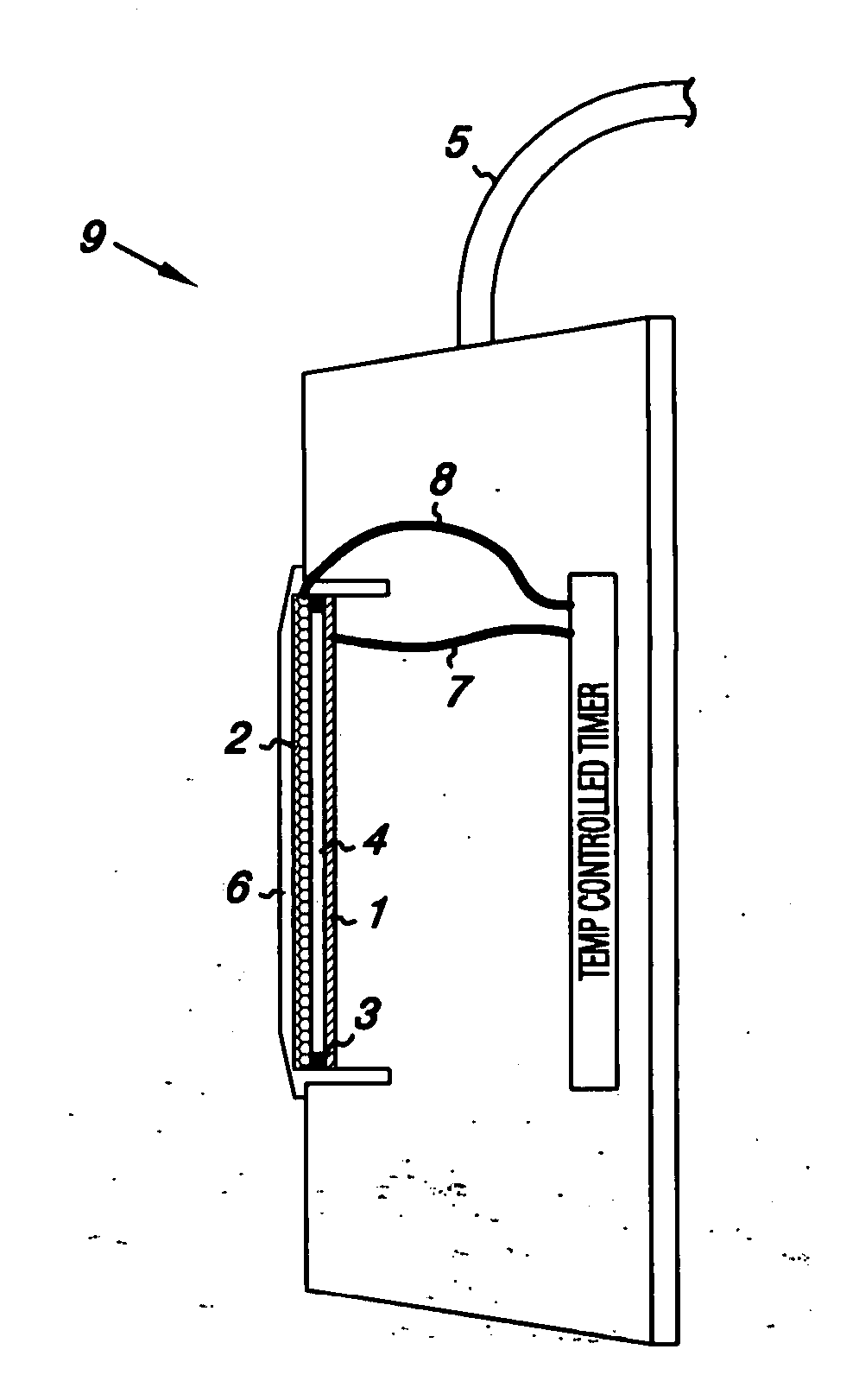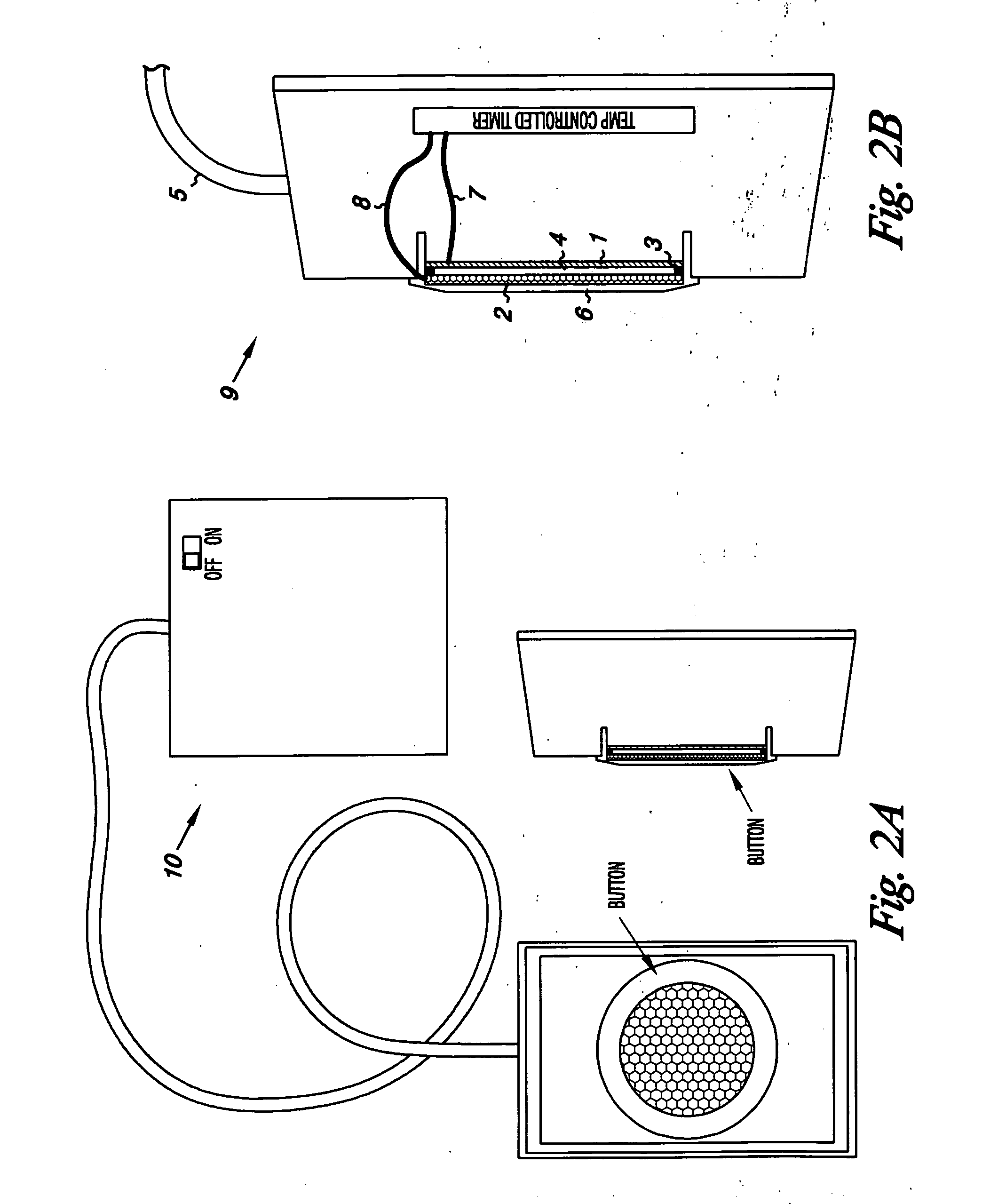Flow-through oxygenator
a flow-through oxygenator and oxygenator technology, applied in the direction of oxidation water/sewage treatment, sustainable biological treatment, seed and root treatment, etc., can solve the problems of adversely affecting life forms, high energy requirements, and many pollutants, and achieve the effect of high energy requirements
- Summary
- Abstract
- Description
- Claims
- Application Information
AI Technical Summary
Benefits of technology
Problems solved by technology
Method used
Image
Examples
example 1
Oxygen Emitter
[0037] As shown in FIG. 1, the oxygen evolving anode 1 selected as the most efficient is an iridium oxide coated single sided sheet of platinum on a support of titanium (Eltech, Fairport Harbor, Ohio). The cathode 2 is a 1 / 16 inch mesh (size 8 mesh) marine stainless steel screen. The anode and cathode are separated by a non-conducting spacer 3 containing a gap 4 for the passage of gas and mixing of anodic and cathodic water and connected to a power source through a connection point 5. FIG. 2 shows a plan view of the assembled device. The O2 emitter 6 with the anode connecting wire 7 and the cathode connecting wire 8 is contained in an enclosure 9, connected to the battery compartment 10. The spacer thickness is critical as it sets the critical distance. It must be of sufficient thickness to prevent arcing of the current, but thin enough to separate the electrodes by no more than 0.140 inches. Above that thickness, the power needs are higher and the oxygen bubbles form...
example 2
Measurement of O2 Bubbles
[0041] Attempts were made to measure the diameter of the O2 bubbles emitted by the device of Example 1. In the case of particles other than gasses, measurements can easily be made by scanning electron microscopy, but gasses do not survive electron microscopy. Large bubble may be measured by pore exclusion, for example, which is also not feasible when measuring a gas bubble. A black and white digital, high contrast, backlit photograph of treated water with a millimeter scale reference was shot of water produced by the emitter of Example 1. About 125 bubbles were seen in the area selected for measurement. Seven bubbles ranging from the smallest clearly seen to the largest were measured. The area was enlarged, giving a scale multiplier of 0.029412.
[0042] Recorded bubble diameters at scale were 0.16, 0.22, 0.35, 0.51, 0.76, 0.88 and 1.09 millimeters. The last three were considered outliers by reverse analysis of variance and were assumed to be hydrogen bubbles...
example 3
Other Models of Oxygen Emitter
[0043] Depending on the volume of fluid to be oxygenated, the oxygen emitter of this invention may be shaped as a circle, rectangle, cone or other model. One or more may be set in a substrate that may be metal, glass, plastic or other material. The substrate is not critical as long as the current is isolated to the electrodes by the nonconductor spacer material of a thickness from 0.005 to 0.075 inches, preferably 0.050 inches. It has been noticed that the flow of water seems to be at the periphery of the emitter, while the evolved visible bubbles (H2) arise at the center of the emitter. Therefore, a funnel or pyramidal shaped emitter was constructed to treat larger volumes of fluid. FIG. 4 is a cross sectional diagram of such an emitter. The anode 1 is formed as an open grid separated from a marine grade stainless steel screen cathode 2 by the critical distance by spacer 3 around the periphery of the emitter and at the apex. This flow-through embodime...
PUM
| Property | Measurement | Unit |
|---|---|---|
| size | aaaaa | aaaaa |
| size | aaaaa | aaaaa |
| energy | aaaaa | aaaaa |
Abstract
Description
Claims
Application Information
 Login to View More
Login to View More - R&D
- Intellectual Property
- Life Sciences
- Materials
- Tech Scout
- Unparalleled Data Quality
- Higher Quality Content
- 60% Fewer Hallucinations
Browse by: Latest US Patents, China's latest patents, Technical Efficacy Thesaurus, Application Domain, Technology Topic, Popular Technical Reports.
© 2025 PatSnap. All rights reserved.Legal|Privacy policy|Modern Slavery Act Transparency Statement|Sitemap|About US| Contact US: help@patsnap.com



